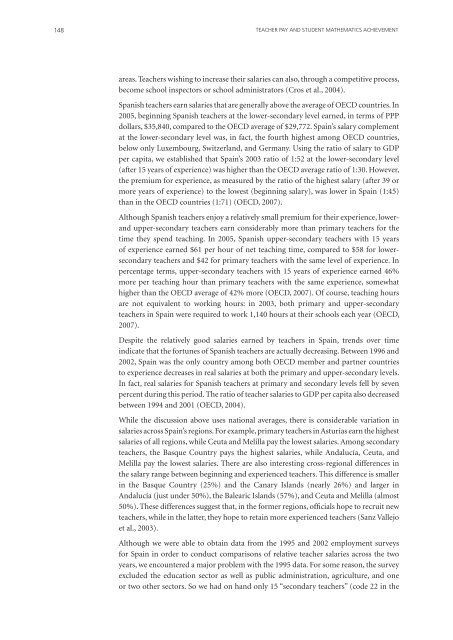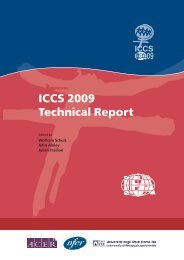Teacher Education and Development Study in Mathematics - IEA
Teacher Education and Development Study in Mathematics - IEA
Teacher Education and Development Study in Mathematics - IEA
You also want an ePaper? Increase the reach of your titles
YUMPU automatically turns print PDFs into web optimized ePapers that Google loves.
148<br />
TEACHER PAY AND STUDENT MATHEMATICS ACHIEVEMENT<br />
areas. <strong>Teacher</strong>s wish<strong>in</strong>g to <strong>in</strong>crease their salaries can also, through a competitive process,<br />
become school <strong>in</strong>spectors or school adm<strong>in</strong>istrators (Cros et al., 2004).<br />
Spanish teachers earn salaries that are generally above the average of OECD countries. In<br />
2005, beg<strong>in</strong>n<strong>in</strong>g Spanish teachers at the lower-secondary level earned, <strong>in</strong> terms of PPP<br />
dollars, $35,840, compared to the OECD average of $29,772. Spa<strong>in</strong>’s salary complement<br />
at the lower-secondary level was, <strong>in</strong> fact, the fourth highest among OECD countries,<br />
below only Luxembourg, Switzerl<strong>and</strong>, <strong>and</strong> Germany. Us<strong>in</strong>g the ratio of salary to GDP<br />
per capita, we established that Spa<strong>in</strong>’s 2003 ratio of 1:52 at the lower-secondary level<br />
(after 15 years of experience) was higher than the OECD average ratio of 1:30. However,<br />
the premium for experience, as measured by the ratio of the highest salary (after 39 or<br />
more years of experience) to the lowest (beg<strong>in</strong>n<strong>in</strong>g salary), was lower <strong>in</strong> Spa<strong>in</strong> (1:45)<br />
than <strong>in</strong> the OECD countries (1:71) (OECD, 2007).<br />
Although Spanish teachers enjoy a relatively small premium for their experience, lower<strong>and</strong><br />
upper-secondary teachers earn considerably more than primary teachers for the<br />
time they spend teach<strong>in</strong>g. In 2005, Spanish upper-secondary teachers with 15 years<br />
of experience earned $61 per hour of net teach<strong>in</strong>g time, compared to $58 for lowersecondary<br />
teachers <strong>and</strong> $42 for primary teachers with the same level of experience. In<br />
percentage terms, upper-secondary teachers with 15 years of experience earned 46%<br />
more per teach<strong>in</strong>g hour than primary teachers with the same experience, somewhat<br />
higher than the OECD average of 42% more (OECD, 2007). Of course, teach<strong>in</strong>g hours<br />
are not equivalent to work<strong>in</strong>g hours: <strong>in</strong> 2003, both primary <strong>and</strong> upper-secondary<br />
teachers <strong>in</strong> Spa<strong>in</strong> were required to work 1,140 hours at their schools each year (OECD,<br />
2007).<br />
Despite the relatively good salaries earned by teachers <strong>in</strong> Spa<strong>in</strong>, trends over time<br />
<strong>in</strong>dicate that the fortunes of Spanish teachers are actually decreas<strong>in</strong>g. Between 1996 <strong>and</strong><br />
2002, Spa<strong>in</strong> was the only country among both OECD member <strong>and</strong> partner countries<br />
to experience decreases <strong>in</strong> real salaries at both the primary <strong>and</strong> upper-secondary levels.<br />
In fact, real salaries for Spanish teachers at primary <strong>and</strong> secondary levels fell by seven<br />
percent dur<strong>in</strong>g this period. The ratio of teacher salaries to GDP per capita also decreased<br />
between 1994 <strong>and</strong> 2001 (OECD, 2004).<br />
While the discussion above uses national averages, there is considerable variation <strong>in</strong><br />
salaries across Spa<strong>in</strong>’s regions. For example, primary teachers <strong>in</strong> Asturias earn the highest<br />
salaries of all regions, while Ceuta <strong>and</strong> Melilla pay the lowest salaries. Among secondary<br />
teachers, the Basque Country pays the highest salaries, while Andalucía, Ceuta, <strong>and</strong><br />
Melilla pay the lowest salaries. There are also <strong>in</strong>terest<strong>in</strong>g cross-regional differences <strong>in</strong><br />
the salary range between beg<strong>in</strong>n<strong>in</strong>g <strong>and</strong> experienced teachers. This difference is smaller<br />
<strong>in</strong> the Basque Country (25%) <strong>and</strong> the Canary Isl<strong>and</strong>s (nearly 26%) <strong>and</strong> larger <strong>in</strong><br />
Andalucía (just under 50%), the Balearic Isl<strong>and</strong>s (57%), <strong>and</strong> Ceuta <strong>and</strong> Melilla (almost<br />
50%). These differences suggest that, <strong>in</strong> the former regions, officials hope to recruit new<br />
teachers, while <strong>in</strong> the latter, they hope to reta<strong>in</strong> more experienced teachers (Sanz Vallejo<br />
et al., 2003).<br />
Although we were able to obta<strong>in</strong> data from the 1995 <strong>and</strong> 2002 employment surveys<br />
for Spa<strong>in</strong> <strong>in</strong> order to conduct comparisons of relative teacher salaries across the two<br />
years, we encountered a major problem with the 1995 data. For some reason, the survey<br />
excluded the education sector as well as public adm<strong>in</strong>istration, agriculture, <strong>and</strong> one<br />
or two other sectors. So we had on h<strong>and</strong> only 15 “secondary teachers” (code 22 <strong>in</strong> the

















